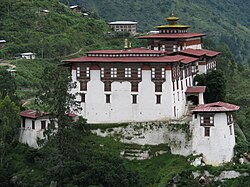| Eastern Bhutan | |
 | |
| State | Bhutan |
|---|---|
Eastern Bhutan is a region of Kingdom of Bhutan.
To know
The predominant ethnic group in eastern Bhutan is Sharchops, who are typically followers of the Nyingma Buddhist tradition and tend to be shorter and stockier than people in other parts of the country. Another feature of eastern Bhutan is that cities and towns are generally built on the slopes of the mountain, a notable exception being the Samdrup Jongkhar which is located in a valley on the border Indian.
The Lhuentse District is one of the most remote and least developed neighborhoods in Bhutan, and the landscape to the north is dominated byHimalaya. The neighborhood is famous for its beautiful and intricately woven fabric. There are no shops that sell it, but you can certainly buy it by visiting the homes of the weavers. Khoma village is a particularly beautiful place to see.
Spoken languages
Sharchopkha is the predominant language of the region, although there are local variants.
Culture and traditions
Some of the typical products of this area are the following:
- Yarns made by National Women's Weaving Center of Khaling.
- Cane baskets and other cane products (ringshu) from the village of Pasaphu in the Thrimshing district.
- Handmade wooden bowls (dappa) are a wonderful and practical keepsake. The two halves of the bowl fit together perfectly, so they can be used to carry cooked food, which is their function in Bhutan. However, they are also excellent bowls for salads or cookies. There dappa is a specialty of the region of Trashiyangtse, and it is possible to buy it directly from the workshops of the artisans.
Territories and tourist destinations
Urban centers
- 1 Deothang - A small town and hill station.
- 2 Khaling - Known for its large variety of birds.
- 3 Lhuntshi - The administrative capital of the Lhuentse district. Other than the dzong, there isn't much to see.
- 4 Mongar (མོང་ སྒར) - A center in the eastern section of the country.
- 5 Samdrup Jongkhar (བསམ་ གྲུབ་ ལྗོངས་ མཁར) - Administrative town on the southeastern border with theIndia.
- 6 Trashigang (བཀྲ་ ཤིས་ སྒང་ །) - A picturesque city in the east of the country.
- 7 Trashiyangtse (or Tashi Yangtse) - Capital of the homonymous district with an important art school.
- 8 Wamrong - Located along the highway between Trashigang is Samdrup Jongkhar.
Other destinations
- 1 Protected natural area of Bumdeling (Bumdeling Wildlife Sanctuary) - Contains different types of flora, fauna and landscapes, including alpine lakes and the Bumdeling Valley.
- 2 Jomotsangkha Natural Protected Area (Jomotsangkha Wildlife Sanctuary, ex Khaling Wildlife Sanctuary) - Important habitat for elephants, gaur and other tropical wild animals.
- 3 Sakteng protected natural area (Sakteng Wildlife Sanctuary) - It is part of the subalpine coniferous forests ecoregion ofHimalaya Oriental.
- 4 Singye Dzong - A sacred valley and monastery founded by Yeshi Tsogyal and visited by Guru Rinpoche on his second visit to Bhutan. It is three days' walk from the Khoma settlement.
How to get
By bus
You can get there from Thimphu and from the border crossing with theIndia to Samdrup Jongkhar.
How to get around
What see
- Dzong's Mongar
- Aja-nye cave - AH is a sacred Buddhist symbol and nye means 100. The name comes from the 100 AH symbols that miraculously appeared on the cave walls. Guru Rinpoche practiced meditation here, and it is an important pilgrimage site. Aja-nye is a day's walk from Yadi settlement.
- Yongla Gompa - Famous monastery perched above the village of Oron.
- Bhangtar - Area inhibited by many Bhutanese of origin Nepalese. The clean river and wide valley offer a good place to picnic and swim (although not in the rainy season).
- Red-necked hornbill - Widespread bird in the district, especially around the Bangtar settlement.
- Sherabtse College - The highest educational institution in the country.
- Trashigang dzong - A traditional dzong perched on a hilltop near Trashigang.
- Chorten Kora - An impressive stupa similar to the famous Boudhanath Stupa a Katmandu.
What to do
- Chorten Kora Tsechu - Local festival which generally takes place between February and March.
At the table
Drinks
The local homemade drinks available are ara (the most popular), singchang, bangchang.
The government breweries of Samdrup Jongkhar (Eastern Bhutan), Gelephu (Southern Bhutan), and Samtse (Southern Bhutan) feature whiskey, rum, brandy, and gin.
In Central Bhutan peach and apple brandies are also available.
The beers produced in Bhutan are Druk 11000 and Red Panda.
Drinks Indian such as Hit Beer, Dansberg beer, Figuera red wine and Spry Red wine are also available at discounted prices (from the Indian government).
Overall, drinks are available literally everywhere, with a majority of shops being "bar-shops".
At the main hospital in Thimphu (JDWNRH acronym for Jigme Dorji Wangchuck National Referral Hospital), estimate that 80% of deaths are attributed to alcohol (excluding collateral damage such as drunk driving, murder under the influence, etc.).
